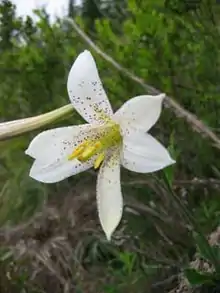Lilium washingtonianum
Lilium washingtonianum is a North American plant species in the lily family.[1][2][3] It is also known as the Washington lily, Shasta lily, or Mt. Hood lily. It is named after Martha Washington[2] and not the state of Washington; in fact, as the northern range of the plant is near Mount Hood in Oregon, it does not naturally occur in the state of Washington.
| Lilium washingtonianum | |
|---|---|
 | |
| Scientific classification | |
| Kingdom: | |
| (unranked): | |
| (unranked): | Monocots |
| Order: | |
| Family: | |
| Genus: | |
| Species: | L. washingtonianum |
| Binomial name | |
| Lilium washingtonianum | |
Lilium washingtonianum is native to the Cascade Range and Sierra Nevada of western North America. Its range is limited to the states of California and Oregon.[4]
Description
Lilium washingtonianum grows up to 2 m tall, and bears large fragrant white or pinkish flowers that are often decorated with purplish spots. The tepals are 6 to 9 cm long and not strongly reflexed. It is typically found in chaparral, open woods, recently burned areas, or revegetating clearcuts.[5]
- Subspecies[4]
- Lilium washingtonianum subsp. purpurascens (Stearn) M.W.Skinner - flowers aging deep pink or lavender
- Lilium washingtonianum subsp. washingtonianum - flowers aging pink or white
References
- Kew World Checklist of Selected Plant Families
- Kellogg, Albert. 1859. Hesperian (San Francisco) 3: 340
- Kellogg, Albert 1863. Proceedings of the California Academy of Sciences 2: 13–14
- Flora of North America Vol. 26 Page 182 Washington lily Lilium washingtonianum Kellogg, Hesperian (San Francisco). 3: 340. 1859.
- Hitchcock, Charles Leo and Cronquist, Arthur. Flora of the Pacific Northwest. University of Washington Press, ISBN 0-295-95273-3.